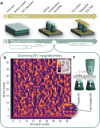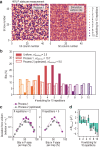A quantum sensing metrology for magnetic memories
- PMID: 38883426
- PMCID: PMC11177792
- DOI: 10.1038/s44306-024-00016-5
A quantum sensing metrology for magnetic memories
Abstract
Magnetic random access memory (MRAM) is a leading emergent memory technology that is poised to replace current non-volatile memory technologies such as eFlash. However, controlling and improving distributions of device properties becomes a key enabler of new applications at this stage of technology development. Here, we introduce a non-contact metrology technique deploying scanning NV magnetometry (SNVM) to investigate MRAM performance at the individual bit level. We demonstrate magnetic reversal characterization in individual, <60 nm-sized bits, to extract key magnetic properties, thermal stability, and switching statistics, and thereby gauge bit-to-bit uniformity. We showcase the performance of our method by benchmarking two distinct bit etching processes immediately after pattern formation. In contrast to ensemble averaging methods such as perpendicular magneto-optical Kerr effect, we show that it is possible to identify out of distribution (tail-bits) bits that seem associated to the edges of the array, enabling failure analysis of tail bits. Our findings highlight the potential of nanoscale quantum sensing of MRAM devices for early-stage screening in the processing line, paving the way for future incorporation of this nanoscale characterization tool in the semiconductor industry.
Keywords: Electronic and spintronic devices; Quantum metrology.
© The Author(s) 2024.
Conflict of interest statement
Competing interestsThe authors declare no competing interests.
Figures





References
-
- Reinsel, D., Gantz, J. & Rydning, J. Data Age 2025: The Evolution of Data to Life-critical. IDC White Paper (IDC, 2017).
-
- Dieny B, et al. Opportunities and challenges for spintronics in the microelectronics industry. Nat. Electron. 2020;3:446–459. doi: 10.1038/s41928-020-0461-5. - DOI
-
- Baltz V, et al. Antiferromagnetic spintronics. Rev. Mod. Phys. 2018;90:015005. doi: 10.1103/RevModPhys.90.015005. - DOI
-
- Du, A. et al. Electrical manipulation and detection of antiferromagnetism in magnetic tunnel junctions. Nat. Electron. 10.1038/s41928-023-00975-3 (2023).
LinkOut - more resources
Full Text Sources
